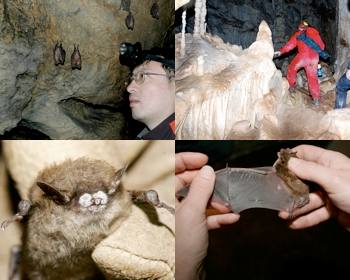A Publication of the
Applied Math and Science Education Repository

The AMSER Science Reader Monthly aims to provide educators with a useful package of information about a particular topic related to applied math and science by combining freely available articles from popular journals with curriculum, learning objects, and web sites from the AMSER portal. The AMSER Science Reader Monthly is free to use in the classroom and educators are encouraged to contact AMSER with suggestions for upcoming issues or comments and concerns at [email protected].
This month's AMSER Science Reader Monthly topic is Sustainable Agriculture.
Bat Crash
Article
by David Qaummen
Synopsis and resource annotations by Max Grinnell

This piece from the December 2010 issue of National Geographic explores this troubling situation, and it begins with a description of the U.S. Geological Survey's National Wildlife Health Center in Madison, Wisconsin. This secure facility contains habitats for prairie dogs, zebra finches, and tiny brown bats. All of these animals are part of various scientific experiments on wildlife health, and David S. Blehert, a microbiologist at the Wildlife Health Center, is looking at how this fungus is affecting the bats.
So far, Blehert and others in the field have observed that this new fungus (and White-Nose Syndrome, the disease it causes) is the first one to target a hibernating animal. The fungus appears to be new to North America, and its presence was first noted at a cave west of Albany, New York in February 2006. A team of experts from New York's Department of Environmental Conservation made an inspection of a nearby cave and found thousands of dead bats . In the past few years, biologists estimate that over a million bats of various species have died from this mysterious fungus throughout the U.S., with populations at some sites eliminated.
Scientists have determined that what makes the fungus lethal is that it strikes hibernating bats. Usually, fungi don't cause serious problems in warm-blooded creatures, but since the physiology of hibernation in mammals includes the lowering of body temperature and other metrics of metabolism, the animals become quite vulnerable. Scientists remain interested in locating the origins of the fungus, but that has proved difficult. They are puzzled as to why this fungal infection develops into the dreaded White-Nose Syndrome (WNS). This is when the fungus covers the snout fur of the bat and causes corrosive white lesions on the wings and early arousal from hibernation. There are many unanswered questions about this fungus, and it is something that curious parties will want to keep tabs on over the coming months and years.
Found below is a list of useful resources that will illuminate and enhance understanding of the topics found within this article. The first link will take visitors to a great site from the Wildlife Disease Information Node from the National Biological Information Infrastructure that includes interactive maps of animal diseases around the world, complete with numerous filters and extra features. The second link leads to the homepage of the Bat Conservation Trust, where visitors will find a trove of materials on all things bats, White-Nose Syndrome, and much more. Moving along, the third link will take interested parties to an excellent website from the U.S. Fish and Wildlife Service, which is dedicated to collecting and disseminating information about White Nose Syndrome. The fourth link leads to the University of Bristol's Bat Ecology and Bioacoustics Lab where visitors will find a useful set of tools to learn about bats, including their Interactive Biosonar site, which teaches about seeing with sound. The fifth link provides a great set of instructional materials on the processes animals use to adapt to the changing seasons, including migrations and hibernations. Finally, the last link leads to the homepage of the Wildlife Conservation Research Unit at Oxford University. Here visitors can learn about wildlife conservation efforts around the world and read relevant reports.




